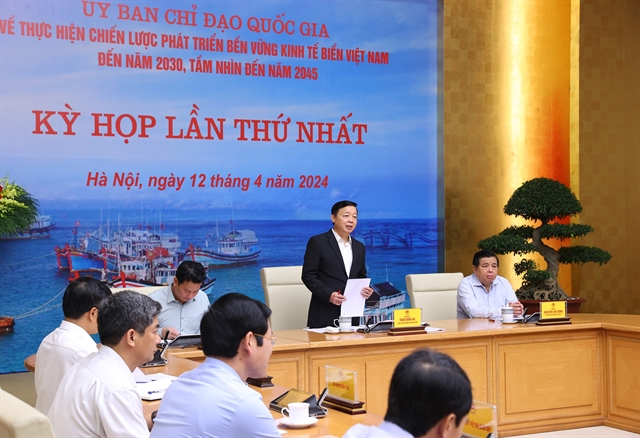 Society
Society

 |
| Deputy Prime Minister Trần Hồng Hà delivers a speech on Friday at the conference on the implementation of the Sustainable Development Strategy for Việt Nam's maritime economy by 2030, with a vision to 2045. - VNA/VNS Photo |
HÀ NỘI — Deputy Prime Minister Trần Hồng Hà called upon ministries, sectors and local administrations to invest in the development and modernisation of coastal urban systems, enhancing comprehensive transportation infrastructure and bolstering connectivity for the maritime economy throughout regions.
He was speaking during a hybrid conference on Friday on implementing the Sustainable Development Strategy for Việt Nam's maritime economy by 2030, with a vision to 2045. Representatives from 28 coastal localities participated in the event.
The Ministry of Natural Resources and Environment presented a report assessing the results of the five years (2018-2022) in implementing the Sustainable Development Strategy for Việt Nam's maritime economy by 2030, with a vision to 2045.
In 2022, the gross regional domestic product (GRDP) of the 28 coastal cities and provinces reached VNĐ4.78 trillion (US$191 million), accounting for 49.8 per cent of the national gross domestic product (GDP). The contribution of the GRDP of these localities to the total national GDP in 2022 reached 50.07 per cent.
Regarding the development of the coastal and near-coastal economy, the tourism sector has witnessed rapid growth, reshaping the appearance of coastal urban areas. Modern coastal tourism centres have been established with diverse marine tourism products such as resort tourism, beach bathing, sightseeing tours, and ecotourism.
The maritime economy has achieved many successes, with transport capacity steadily improving to meet transportation needs. As of the end of 2022, Việt Nam's total fleet comprised 1,477 vessels with a total deadweight tonnage of 11.6 million DWT and a total capacity of approximately 7 million GT.
In recent years, the country has constructed several large gas-fired power plants using modern technology and domestically extracted gas resources. By the end of 2022, the oil and gas industry had extracted over 425 million tonnes of oil and condensate, along with over 173 billion cubic metres of gas. Despite global and domestic economic challenges, the oil and gas sector contributed approximately 10 per cent to the total State budget revenue.
The seafood industry has played a crucial role in socio-economic development, generating significant production value, with many products achieving export turnover exceeding $1 billion. Aquaculture and seafood exploitation have gradually increased over the years, with over 3.85 million tonnes of seafood caught and 5.14 million tons of aquaculture production in 2022, representing a 6.4 per cent increase compared to the previous year.
In terms of renewable energy sources for electricity production, in 2022, renewable energy, including hydroelectric, wind, solar, and biomass power reached approximately 130 billion kWh, accounting for nearly 48 per cent of Việt Nam's total electricity output.
There are 19 coastal economic zones in the approved planning with a total area of approximately 871,500ha. By the end of 2022, these coastal economic zones had attracted 553 foreign-invested projects with a total registered investment capital of $54.36 billion.
At the conference, experts and leaders from ministries, sectors, and localities outlined the challenges and existing issues hindering the economic exploitation of many coastal areas.
They also proposed suggestions for sustainable development of the maritime economy, such as refining decrees on coastal zoning, marine spatial planning, and enhancing the State's management role in coastal and island areas.
In his directive at the conference, Deputy PM Hà urged continued investment in developing and modernising coastal urban systems, upgrading comprehensive and modern transportation infrastructure, and fostering connectivity for the maritime economy across regions and localities.
He emphasised the importance of efficiently utilising coastal landscapes, expanding the range of tourism offerings, and advancing modern, interconnected tourism infrastructure to maximise the sector's potential.
He also encouraged the establishment of renewable energy centres to serve production, and daily activities as well as ensuring national defence and security.
Hà stated that ministries, sectors, and localities should invest in storm shelter areas and coastal and island infrastructure projects, as well as developing comprehensive infrastructure for aquaculture development to support farming, fishing and processing, with a focus on investing in modern technology and techniques for offshore aquaculture.
There is an urgent need to develop plans for implementing the national marine spatial planning, he said, adding that it is crucial to promote policies for maritime economic development, strengthen the construction of resource and environmental databases, and establish a national marine information database. — VNS




